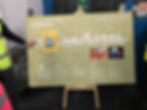James Cropper PLC - Overview
- Drew
- Dec 7, 2017
- 2 min read
Updated: Feb 19, 2019
I was invited to visit James Cropper PLC at their site in Kendall. There has been a mill of some sort on the site since the 13th Century, but James Cropper was not established until 1845. The current chairman is the great, great, great grandson of the company's founder and namesake, Mark Cropper.

The tour of the site took us through their lab where we were given a small scale demonstration of the principles of how paper is made. Next we were shown how paper samples need to be colour matched under the correct light conditions that they will be ultimately viewed or displayed. The samples on the card in the picture appear to be a match, but when viewed in a light box at different lighting colour temperature values, the samples appear different to each other.
The Pulping and Blending processes are mesmerising to watch. The paper pulp is mixed together in huge vats where it has water and colour added to it.

The Wire and Press section is where the pulp is poured out onto a wire conveyor belt where around 50% of the water is removed and recirculated.

After the wire section, a Dandy roll might be used to impart a pattern into the surface of the paper.
While the example below shows paper that is given a pattern later on in the process, it is an example of a pattern that might be added. This particular set of rollers are really expensive to create and set up so that they run in conjunction to each-other on the top and bottom of the paper simultaneously. It is details like this, along with particular paper recipes, colours, or finishes that give the end product a bespoke quality that is unlikely to be counterfeited.
The paper is pressed then dried, after which a solution is pressed into it to help with the printing quality. The final result of the process is huge rolls of paper.

Overall, I really enjoyed this site visit as it satisfied my fascination for finding out how things are made, and I also really like good quality paper. I will be posting the next part of this tour separately as I feel it deserves it's own post.












